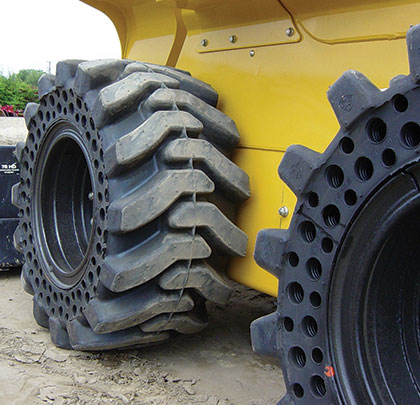As history has taught us, any time a new product enters the market, there will always be at least a few skeptics. So it is no wonder that when the semi-pneumatic tire was introduced several years back, it was met with its fair share of doubts. Here was a tire that boasted the best features over any other tire and came with a big price tag to match. It looked like it may be a rough road ahead for the semi-pneumatic tire. As with any new technology, this product wasn’t going to gain acceptance overnight.
Fast forward to the present. The semi-pneumatic tire has been rapidly growing in popularity as people have begun to realize that it does live up to its long list of promises. While pneumatic tires still come standard on all skid steers, many skid steer tire manufacturers have recognized the demand for semi-pneumatics and have begun to offer their own models.
While no longer considered a “new” product, manufacturers of this tire are constantly incorporating the most recent developments in tire technology in an attempt to eliminate every concern that comes along with other types of skid steer tires, without sacrificing performance in any area. The innovative design not only provides the operator with a cushioned, comfortable ride, but it also virtually eliminates standard maintenance concerns. And perhaps the greatest benefit of this tire is that the design eliminates the possibility of downtime because it is completely flat-proof.
DOING AWAY WITH DOWNTIME
As any contractor knows, the replacement cost isn’t what is feared the most when a tire goes flat. Because a company may receive reduced compensation or even fines if work is not completed on time, every minute on the job is important. When a tire goes flat, the lost time and productivity during the repair or replacement is much more detrimental than the cost of the tire itself.
Under the best circumstances, a flat tire can be changed and the business is only out a small amount of time. But what happens when the skid steer is working on a rural or remote jobsite with no readily available spare tire or equipment to change it? All of a sudden, the machine has become useless. And with no machine to work with, the skid steer operator becomes unproductive. This downtime is both frustrating and costly to a business.
The standard pneumatic tire, while being the most inexpensive, comfortable, and widely used tire on the market, comes with one large drawback—it has the best chance of going flat. Because it contains compressed air, any puncture will result in the air leaking out, rendering the tire useless.
The solid rubber tire was introduced to consumers with one significant promise—it would never go flat. Composed entirely of rubber, it eliminates the possibility of flats by not incorporating compressed air. While this tire achieves the goal of eliminating flats successfully, it has proved to be less than ideal when it comes to providing a comfortable ride.
The foam-filled tire was the next product on the scene and attempted to address both concerns. It is designed with a foam-filled interior to eliminate the chance of flats, while still providing a comfortable ride. Although it provides more cushioning than a solid rubber tire, it is still nowhere near the level of a pneumatic. And there is still the possibility that the tire may be punctured and the foam filling will leak out. If this happens, the operator is back to the same problem he had in the first place—downtime due to a flat.
The semi-pneumatic tire has eliminated this problem because it simply cannot go flat. This durable rubber tire contains several strategically placed air pockets, allowing it to offer the cushioning effects of pneumatics but without the chance of flats. And because the air is not confined, the tire can roll over sharp objects, be punctured, and still continue to work.
BUILT FOR THE LONG HAUL
In addition to being completely flat-proof, the semi-pneumatic tire is designed to outlast all others. While the price tag on this tire can be up to three times more than a pneumatic, the semi-pneumatic has been shown to last three to five times longer.
One factor attributing to this longevity is the heavy-duty rubber composition. The semi-pneumatic consists of 1/3 more rubber than a pneumatic tire and has a much deeper tread than other tires with treads. This provides greater traction on a variety of surfaces including snow, sand, and deep mud, while giving the semi-pneumatic a longer wear factor than other types of tires.
Now, one may think that the solid rubber tire would be the longest lasting because of its heavy-duty, all-rubber composition and lack of tread. And yes, this assumption would be correct. However, because there is no tread, there is also zero traction. This would greatly limit the surfaces on which the tire could be utilized, so productivity would be lost. A semi-pneumatic provides a long wear factor and also offers the ability to traverse a variety of terrain.
Not only can this tire be used on several types of surfaces, it can withstand ground that is littered with debris. Glass, nails, or other sharp objects pose no threat to a semi-pneumatic; because, for one, it can be punctured and not go flat; and two, the composition makes it almost impossible to severely damage the tire. ■
The comfort factor and worry-free maintenance will be the focus of Part 2 of this article in the next issue of MCS.
About The Author:
McLaren Industries is a manufacturer of rubber tracks and tires for skid steers, mini excavators, track loaders, backhoes, and other construction equipment. For more information on semi-pneumatic tires, visit www.mclarenindustries.com.
_________________________________________________________________________
Modern Contractor Solutions, February 2015
Did you enjoy this article?
Subscribe to the FREE Digital Edition of Modern Contractor Solutions magazine.

The Pneu Kid in Town: Part 1


